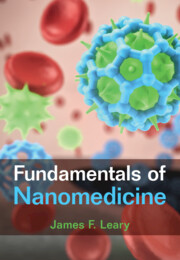Book contents
- Fundamentals of Nanomedicine
- Fundamentals of Nanomedicine
- Copyright page
- Dedication
- Contents
- Preface
- Acknowledgments
- 1 The Need for New Perspectives in Medicine
- 2 Nanomedicine: Single-Cell Medicine
- 3 Targeted Drug Delivery
- 4 Drug Delivery Cell Entry Mechanisms
- 5 Nanomaterial Cores for Noninvasive Imaging
- 6 Attaching Biomolecules to Nanoparticles
- 7 Characterizing Nanoparticles
- 8 Nanomedicine Drug Dosing
- 9 Nanodelivery of Therapeutic Genes
- 10 Assessing Nanomedical Therapies at the Single-Cell Level
- 11 Nanotoxicity at the Single-Cell Level
- 12 Designing Nanodelivery Systems for In Vivo Use
- 13 Designing and Testing Nanomedical Devices
- 14 Quality Assurance and Regulatory Issues of Nanomedicine for the Pharmaceutical Industry
- References
- Index
12 - Designing Nanodelivery Systems for In Vivo Use
Published online by Cambridge University Press: 08 March 2022
- Fundamentals of Nanomedicine
- Fundamentals of Nanomedicine
- Copyright page
- Dedication
- Contents
- Preface
- Acknowledgments
- 1 The Need for New Perspectives in Medicine
- 2 Nanomedicine: Single-Cell Medicine
- 3 Targeted Drug Delivery
- 4 Drug Delivery Cell Entry Mechanisms
- 5 Nanomaterial Cores for Noninvasive Imaging
- 6 Attaching Biomolecules to Nanoparticles
- 7 Characterizing Nanoparticles
- 8 Nanomedicine Drug Dosing
- 9 Nanodelivery of Therapeutic Genes
- 10 Assessing Nanomedical Therapies at the Single-Cell Level
- 11 Nanotoxicity at the Single-Cell Level
- 12 Designing Nanodelivery Systems for In Vivo Use
- 13 Designing and Testing Nanomedical Devices
- 14 Quality Assurance and Regulatory Issues of Nanomedicine for the Pharmaceutical Industry
- References
- Index
Summary
The normal paradigm for developing a new nanomedical system is to start with an in vitro cell line (usually human) system and then progress to excised, or biopsied , tissue from a human (ex vivo). Finally, to better simulate the effects of a total organism, we begin in vivo studies, usually on an animal system. This has been the general paradigm for decades. Now we have new “organ-on-a-chip” in vitro models that generate organ-like human tissue on an in vitro format. There have even been more recent promising efforts at generating “human-on-a-chip” technologies.
Keywords
- Type
- Chapter
- Information
- Fundamentals of Nanomedicine , pp. 232 - 254Publisher: Cambridge University PressPrint publication year: 2022

